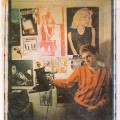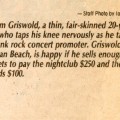(Courtesy of Mikel Toombs, a story by Paul Krueger that appeared in the San Diego Union on July 25, 1978, and features some familiar names and faces.)
 Promoter Bets His Shirt on Punk Rockers
Promoter Bets His Shirt on Punk Rockers
"Our luck has been good so far," Tom Griswold said between bites of corn chips and canned bean dip. "We haven't lost much money. But even if we did, I'd keep at it 'til I lost my shirt."
Griswold, a thin, fair-skinned 20-year-old who taps his knee nervously as he talks, is a concert promoter. But while money means a lot to most promoters, Griswold is happy if he sells enough tickets to pay the $250 rental fee for the nightclub and has $100 left to split between the two bands.
Griswold and his friends are trying hard to interest young San Diegans in "punk" rock — a loud, raucous extract of 1960s rock 'n' roll. Punk, or "new wave," as the music also is known, first caught the attention of England's teen-agers in late 1975. Groups like the Clash, Buzzcocks and the Sex Pistols hit young audiences with an energy, urgency and intensity that had been missing from rock music for a decade.
 Punk was an alternative to the ennui and commercialism which the youths felt had combined to strangle the creativity of pop musicians. New-wave songs often had strong anti-social lyrics ("You wanna survive*You better learn how to lie*Don't use the rules*They're not for you*They're for the fools."), and both performers and their audiences shocked staid England by wearing inch-thick eye makeup and combat boots, dying their hair orange and blue and piercing their noses and cheeks with safety pins.
Punk was an alternative to the ennui and commercialism which the youths felt had combined to strangle the creativity of pop musicians. New-wave songs often had strong anti-social lyrics ("You wanna survive*You better learn how to lie*Don't use the rules*They're not for you*They're for the fools."), and both performers and their audiences shocked staid England by wearing inch-thick eye makeup and combat boots, dying their hair orange and blue and piercing their noses and cheeks with safety pins.
By late 1976, music reviewers and record industry savants Issued their initial critiques of the new wave. "The latest musical garbage. ... punk will fade," wrote Derek Jewell of the London Sunday Times. "It's a fad," pronounced Dan Loggins of CBS Records.
But the punk groups and their followers proved the critics wrong. The new wave swept across the Atlantic into New York where musicians like Patti Smith and the Talking Heads drew turn-away crowds at Greenwich Village nightclubs. Major record firms signed the groups and booked them on national tours. In Los Angeles and San Francisco, clubs began opening their doors to punk bands.
San Diego caught the tail end of several touring shows, including Smith and punk precursor Iggy Pop, early in 1977, but the first completely local show wasn't staged until last Oct. 8.
Tom Brannon, a punk fanatic and former manager of the Bacchanal nightclub in Clairemont, rented the old VFW hall on Adams Avenue in Normal Heights, blanketed the city with mimeographed fliers and enticed more than 300 teen-agers to see the Dills [sic], the Hitmakers and the Zeros, all hometown bands.
Brannon then booked two financially unsuccessful shows at Straita Head Sound on El Cajon Boulevard before leaving San Diego for Rochester, N.Y., early this year.
More than six months passed without a performance before Griswold, Dan McLain, Mikel Toombs and a few other punk enthusiasts pooled their cash and produced a show July 3. The first new-wave event of 1978, it drew about 180 fans, if, as Griswold said, "you count the band members and their friends." The promoters came close to breaking even, and continued with their plan to hold new-wave concerts every Monday night at Abbey Road, a teen-age disco-nightclub on University Avenue.
Two recent concerts featuring bands from San Diego and Los Angeles drew more than 250 devotees, and a four-hour show highlighting five local bands, including the Zeros, the Hitmakers and the Penetrators, was scheduled last night.
With few exceptions, the punk audience at Abbey Road is too young to drink and looks no different than the crowds which gather at the Sports Arena to hear commercial hard-rock groups like Van Halen and Aerosmith. But those exceptions would feel comfortable in the most hard-core of London's punk pubs.
One blonde, her faced bathed in multicolored makeup, was dressed in a black corset, black garter belt, matching nylons and pumps — nothing more. Two other women had trimmed their platinum hair so it looked almost like a skull cap.
Several youths sported regulation leather jackets over white T-shirts; others, wearing moth-eaten cardigan sweaters with pencil-thin brown ties and white shirts, looked like disheveled algebra geniuses from a 1950s high school class photo.
Griswold favored a nauseous orange V-neck sweater with black stripes and slip-on tennis shoes; his buddy McLain wore a white shirt with rolled-up sleeves and a tie draped around his shoulders.
Only a handful of the audience danced while 20 or 30 others clustered close to the stage for a better look at the Zeros. The remainder of the audience sat at the tables which surround the dance floor.
While Javier Escovedo, the Zeros' lead guitarist, urged the audience to drop its inhibitions — "Come on," he coaxed, "get closer to the stage" — there was none of the taunting that has given punk bands their infamous — and some say undeserved — reputation for violence. (Some of the first stories told about English punk bands reported their abusive relations with the audience: how they hurled profanities, as well as drumsticks, microphone stands and beer cans into the crowd.)
The Zeros, of all the local bands, probably have made the most statewide impact. The four South Bay youths, aged 16 to 20, have played several times in Hollywood (at the Whiskey and the Stargate [sic]) and at San Francisco's punk club, the Mabuhay Gardens. Early this year, the Zeros released their first single on Bomp Records, and they plan to release a second 45 sometime this summer. The Dills, once based in Carlsbad, have since moved to San Francisco, where they are playing regularly.
Three record stores, Blue Meanie, Monty Rockers and Licorice Pizza, carry the more esoteric new-wave imports and monthly magazines, including New York Rocker and Search and Destroy, a San Francisco-based punk tabloid. The more popular mainstream releases also are available at larger record stores, including Tower and Wherehouse.
Griswold, Mikel Toombs and Jackie Rameriz [sic] also have put together Substitute, a local punk magazine. Its 20 mimeographed pages are filled with interviews of San Diego musicians, record reviews and advertisements soliciting talent. ("Unorthodox female vocalist sought," reads one such ad. "A hysterical shrieking monotone whine is the type of voice we're after.") Another mimeographed handout, Rude Situations, also has been distributed among punk fans.
But the weekly concerts remain the focal point of San Diego's new-wave scene. Griswold is optimistic that attendance will increase and that enough money can be kept in the till to pay the rental and cover travel expense for the bands which journey down from Los Angeles.
And while he decries the apathy which he said afflicts most punk fans — "They say they'll write for the magazine, but they never do; they say they'll sell 40 tickets for the concert and they bring them back unsold" — Griswold seems willing to spend his last nickel before he lets punk perish.
"It's been so long since we've had any real music here. All the local bands make money playing Top 40, and the alternative is disco. And that," Griswold said as he curled his upper lip in disdain, "is a terrible choice to have to make."